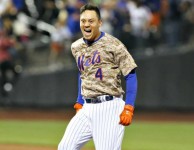
While everyone is trying to decipher the outfield configuration after the Yoenis Cespedes signing, there is the issue of how the signing puts added importance on Wilmer Flores‘ ability to be a backup infielder.
Third Base
Make no mistake. The Mets need Flores to be able to handle the role and handle it well. For starters, we do not know David Wright‘s ability to withstand a full 162 game schedule. Last year, Wright had difficulty playing three days in a row. It impacted his offense and defense. With a full offseason to continue the extra work needed due to his spinal stenosis, that could change for Wright. It also may be a new reality.
Flores has to be ready, willing, and able to play third at a monent’s notice. In his major league career, Flores has only played 209 innings at third base. During that limited time, he did show the ability to handle the position. The problem is he has to work on his third base defense while addressing his second base defense.
Second Base
When the Mets acquired Neil Walker to replace Daniel Murphy, the Mets obtained a switch-hitting second baseman who has hit .272/.338/.427 over the course of his career. That’s with him coming off the worst year of his career last year when he hit .269/.328/.427 with 16 homers and 71 RBI. One of Walker’s issues last year was left-handed pitching. Walker hit a dreadful .237/.284/.290 in 62 games against lefties. For his career, Walker has hit an underwhelming .260/.317/.338 against lefties in his career. Effectively, Walker is a platoon player.
Ideally, that platoon parter would be Flores. However, Flores has to be able to hit lefties himself. Last year, Flores did that with aplomb. In 57 games, Flores hit .310/.355/.600 with 7 of his 16 homers against lefties last year. However, for his career, Flores has only hit .230/.288/.403 against lefties in his brief major league career. Overall, for the Walker trade to work Flores needs to be the 2015 version of himself against lefties as opposed to what he’s done against them in his entire career.
First Base
First base is where it starts to get dicey for Flores. With the Cespedes signing, Lucas Duda became the only player on the roster with any major league experience at first base. This forces Flores to learn a new position in addition to keeping prepared for his other backup roles.
How much Flores is needed will depend on Duda. Last year, Duda hit a respectable .285/.333/.545 with seven homers and 21 RBI in 82 games. However, much of that was fueled by an extraordinarily high BABIP of .385. For his career, Duda has hit .229/.301/.369 with a .321 BABIP. In short, Duda is due for a regression against lefties. It will be Flores’ job to cushion the fall back to earth while hoping his numbers against lefties doesn’t regress either.
Shortstop
The Mets signed Asdrubal Cabrera to be the new everyday shortstop. A role that used to belong to Flores. Cabrera’s backup to open the season should be Ruben Tejada, who actually wrestled the shortstop job away from Flores last year.
Here’s the issue. The one spot Flores isn’t backing up is the one spot he’s most needed. Last year, Cabrera had a -6.0 UZR and a -7 DRS at shortstop. For his career, he has a -55.5 UZR and a -29 DRS at short. Tejada had a -5.6 UZR and a -15 DRS at short last year. For his career, he has a -1.5 UZR and a -20 DRS there. Flores had a -2.5 UZR and a -10 DRS at short last year with a 1.5 UZR and a -13 DRS for his career.
So defensively, Flores is the best shortstop option. However, the Mets are going with Cabrera in the hopes that his .328/.372/.544 second half will carry forward because otherwise the Mets signed a shortstop who has hit .249/.307/.405 in the three years since his last All Star appearance. Ironically, the position Flores is best suited to on this team is not a position he is tops on the depth chart going into next season.
Pinch Hitter
Since this is the National League, Flores will need to be ready to pinch hit for the pitcher or for a left handed when a LOOGY enters the game. In his career, Flores has only had 13 plate appearances where he hit .250/.308/.333. These are around his career numbers of .253/.287/.386. Accordingly, Flores can reasonably be expected to replicate his career batting line as a pinch hitter next year. Whether that’s good or not is a whole other matter.
Conclusion
Surprisingly, much of what the Mets want to do lies on Flores’ shoulders. He had to platoon at second. He had to hit against tough left-handles while playing first. He has to be available at a moment’s notice to play third. He’s available to play each and every one of these roles because the Mets are placing their top shortstop option, Flores, on the bench.
Flores is still only 24 years old. He works hard, and he will do everything he can do to improve and help the team. He’s going to need to be proficient in three to four infield positions because the Mets really need his help.
Editor’s Note: this article first appeared on metsmerized.com
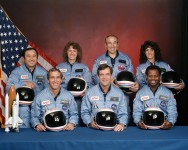
For some reason, when I think of 1986, I only think of the ’86 Mets. I have several ideas why, but it still strikes me as odd that is the correlation I make. No, going into this year, all I thought about was how this is the 30th anniversary of the Mets last World Series title.
Turns out it’s also the 30th anniversary of the Challenger disaster. It was such a bizarre day in seemingly a much different time. Back then, when someone asked a kid what they wanted to be the usual responses were an athlete, a cop, a fireman, an actor, whatever their father did, or an astronaut. Being an astronaut was such a huge deal. Every launch was an event. I’m not sure either of those was the case.
The Challenger liftoff was a huge deal. Teachers combined classes together, and they lugged in those televisions on those large aluminum carts with the squeaky wheel. In my Kindergarten class, we all sat on our carpet squares, and we anticipated the liftoff. The teachers tried to get us to countdown, but I’m not sure how successful they were. The liftoff happened, and we all started cheering. Then the explosion happened.
The TV was quickly turned off. The teachers seemed to know what was happening immediately (even if they didn’t quite know at CNN), and they didn’t want Kindergartners to see the horror that ensued. We were quickly ushered into a new activity. We were all handed notes on our way out the door advising our parents what happened.
When I got home from school, I remembered going outside and playing with my friends. We didn’t really know what happened. We all thought we saw a really cool liftoff. Ironically, we were all pretending to be astronauts that day really knowing the horrors that had ensued. Then my father came home, and I was summoned inside the house. That usually was never a good thing.
My parents then explained to me what happened. When you’re five, it’s a hard concept to fully grasp. Back then, I wasn’t sure what was happening or why the speech. Looking back on it 30 years later, I believe my parents were trying to prepare me for when my grandfather died. At the time, he was dying from throat cancer. I knew he was sick, but back then I thought being sick was not feeling good, drinking some ginger ale, and watching cartoons all day until you felt better.
I remember both having a lot of questions and just wanting to go and play with my friends again. After our talk, my parents turned on the television, and we watched President Reagan address the nation:
The Challenger explosion was the beginning what was an eventful 1986. It was a year, I too lost a family member like families of the Challenger crew. I’m sure it’s of little consolation to them, but their loss helped me process and understand my grandfather’s passing less than three months later.
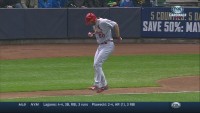
One of the reasons offered for the institution of the DH is to protect pitchers. Pitchers are expensive, and you don’t want them getting injured at the plate or on the basepaths. The theory is the DH would prevent these pitcher injuries.
On the surface, it seems like a reasonable argument. Last year, pitchers made 243 trips to the DL. That’s 213 times more than any other position. Of those 243 trips to the DL, guess how many of them were batter or basepath injuries? There was only one pitcher. Adam Wainwright suffered a torn Achillies tendon while swinging the bat. It’s true that Wainwright was injured while batting, but was he injured because he was batting?
Achillies tendon injuries are due to overuse or tightness in the muscles and tendons. Achillies tendon injuries are common in people who play sports, including baseball players. People who are in their thirties or forties, like Wainwright, are more susceptible to an Achillies injury. Overall, unless you’re involved in a serious accident, an Achillies tendon tear is not caused by any one event.
Yes, Wainwright injured himself while batting, but that was not the cause of his injury. Unfortunately, as is the nature of Achillies tendon injuries, it’s not one event, it’s a multitude of events. The specific act of batting for Wainwright is the straw that broke the camel’s back. It wasn’t the reason he tore his Achillies tendon. It doesn’t work that way.
Yes, there are pitchers who are legitimately injured at the plate or on the basepaths. There are examples, which include getting hit by a pitch, swinging a bat, or running the bases. However, these injuries are few and far between.
Let’s look at it from another perspective. Next to pitchers, left fielders went to the DL more than any other position last year with 30 trips to the DL last year. Let’s assume for a minute each and every single one of the DL trips by left fielders were sustained as a result of batting or baserunning activities. Let’s further assume that regardless of position, any position on the field will have 30 trips to the DL as a result of batting or baserunning activities. Finally, let’s assume these 30 DL trips were already a part of the DL trips made by pitchers last year (this way the denominator of total DL trips isn’t increased).
With all these assumptions, batting and baserunning injuries would only comprise 12.3% of all pitcher injuries. That tells us that the real issue with pitchers is that they get injured with pitching. They rarely get injured batting or running the bases. In fact, the real percentage of pitchers getting injured at the plate or on the basepaths 0% – 0.004% of the time depending on what you believe the cause of Adam Wainwright’s injury was.
If you want to solve the problems with pitchers getting injured, find a way to protect their arms. Keeping them off the basepaths isn’t going to keep them healthy. This is not the reason to add a DH to the National League.
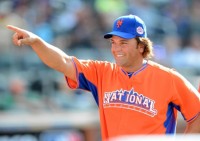
Over at Brew and Orange, they are doing a giveaway for the person who has the best Mike Piazza story. Since the giveaway includes Rheingold beer accessories, which was once the beer of the Mets and my grandfather’s beer of choice, I’m interested. I suggest you go to his site and so your own submission. This is mine.
Back in 2013, my wife was pregnant with our son. At that time, I was already planning on how to make him a Mets fan. We ordered him a knit Mets cap. When I talked to him, I would read books, and of course, I would tell him about the Mets because, well, I have problems. No one believes me, except my wife who was obviously there for this, but I would say, “Lets Go Mets!” and he would kick back three times in the same rhythmic pattern. I digress.
In 2013, the Mets also hosted the All Star Game. For various reasons, my family only went to All Star Sunday, which is the Future’s Game and the All Star Legends and Celebrity All Star Game. My wife suggested we take one of the several Mets onesies we had to get it autographed for the baby. I thought it was a great idea because I would be seeing future Met All Stars like Noah Syndergaard as well as former Met greats like Mike Piazza.
Now, at the time I did work with a guy who used to play minor league ball. In fact, he had a cup of coffee in the majors. He refers to himself as the modern day Moonlight Graham because while he got to play one game, he never got an at bat. The strike happened, and his career was over. This guy told me he played on the same minor league team as Mike Piazza, and he knew him. When I told him my plan, he said he would reach out to him, and he would work to get me that autograph for my son. He eventually told me that I should go meet Piazza by the home dugout after the softball game was over to get my autograph.
With the Future’s Game and Softball Game, I tried to get the onesie signed with no luck. I was alright with that because Piazza was the prize, and I knew exactly when and where to meet him. After the game was over, I made my way down to the home dugout area.
Initially, there was no sight of Piazza. Then again, the area was flooded with people interviewing Kevin James, who was the MVP of the game. No one was really signing anything at the time except him. I just waited there for when Piazza was going to come out and give autographs. I was standing at the exact place and location I was told to stand. I waited and waited and stubbornly waited. Then it happened! Piazza emerged from the home dugout . . . and he immediately made a beeline to the visitor’s dugout area.
I thought this can’t be happening. Something must’ve been lost in translation. Mike Piazza was going to be there looking for me, and I wasn’t going to be there. I was going to miss out on getting an autograph for my son. I then did what every parent does when they are trying to get something for their child. They act quickly and somewhat irrationally. I started jumping the walls that separate each section to get over to Piazza as quickly as possible.
Keep in mind that as I’m doing this there is literally almost no one left at Citi Field. An usher half my size (I’m between 6’5″ – 6’7″ depending on the 7-11) grabs my arm and begins screaming at me. There was some nonsense about respecting Citi Field and how I’m acting like a hoodlum. I exchanged pleasantries as well, but I made sure not to respond physically.
The guy “ushered” me to the stop of the section and turned me over to police explaining the situation. Before I could get a word in edgewise, the police said they saw the whole thing. They mocked the usher and told him to stop bothering me. I explained to the police what I was trying to do, and I sought their help. They told me they couldn’t help and told me I should probably just head home. I was undeterred. I began running all the way to the other side of Citi Field.
By the way, I’m really slow. Almost embarrassingly so. While Piazza might’ve still be there during the hoopla with the usher, he most certainly was not there when I got over there. I went into one of the nearest suites to stand in the air conditioning for a second. Standing there was my brother who actually thought I was fleeing police and security . . . as if that was possible. While I was a free man, I didn’t have Piazza’s autograph.
I went to work the next day, and I apologized to the guy who set everything up. He then began laughing hysterically. He then explained that he did hang out with Piazza a few times in the minors, but he never reached out to him. He had no idea how. I was baffled. I asked him why did he concoct that whe scenario. His response was basically that he figured if Piazza was signing anything, he would do it there. He also figured if Piazza didn’t sign anything he would just say something came up like it does all the time.
Fortunately, I was able to get Mets to sign the onesie and other items for my son. I have a framed Darryl Strawberry jersey (that’s another story) for him. What I don’t have is a Mike Piazza autograph. I’m not sure if I’ll ever get a chance again.
Overall, all of my chances were ushered out the door in July 2013.

In 1973, the American League instituted the DH in order to increase scoring and attendance. It’s now 2016, and there is a call for the National League to adopt the DH for various reasons, including increasing offense. While we can admit a DH is a better hitter than a pitcher, what impact does a DH have upon offense.
To look at offenses, let’s look at baserunners. The best gauge for baserunners is OBP. Here’s the OBP average per team in the AL and NL the past 10 years:
- 2015: AL .318/NL .316
- 2014: AL .316/NL .312
- 2013: AL .320/NL .315
- 2012: AL .320/NL .318
- 2011: AL .322/NL .319
- 2010: AL .327/NL .324
- 2009: AL .335/NL .330
- 2008: AL .335/NL .331
- 2007: AL .338/NL .334
- 2006: AL .339/NL .334
Even with the automatic pitcher outs, there isn’t a great disparity in the OBP between the league’s. However, there are more baserunners in the AL. As a result, it is reasonable to expect that there will be the average AL team will score more runs over the same timeframe:
- 2015: AL 710/NL 666
- 2014: AL 677/NL 640
- 2013: AL 702/NL 649
- 2012: AL 721/NL 683
- 2011: AL 723/NL 668
- 2010: AL 721/NL 701
- 2009: AL 781/NL 718
- 2008: AL 775/NL 734
- 2007: AL 794/NL 763
- 2006: AL 804/NL 771
Again, it is undoubtedly true the average AL team scores more runs over the course of a season, especially in 2009. However, to determine what impact these additional runs have on a game, we need to look at what the average runs an average team scores per game
- 2015: AL 4.38/NL 4.11 Difference 0.27
- 2014: AL 4.18/NL 3.95 Difference 0.21
- 2013: AL 4.33/NL 4.01 Difference 0.32
- 2012: AL 4.45/NL 4.22 Difference 0.23
- 2011: AL 4.46/NL 4.12 Difference 0.34
- 2010: AL 4.45/NL 4.33 Difference 0.12
- 2009: AL 4.83/NL 4.43 Difference 0.40
- 2008: AL 4.78/NL 4.53 Difference 0.25
- 2007: AL 4.90/NL 4.71 Difference 0.19
- 2006: AL 4.96/NL 4.76 Difference 0.20
So overall, even with the DH, the average AL team does not even score a run more per game than the average NL team. the highest differential over the last ten years was in 2009 when it was 0.40 runs per game. There may be different reasons to explain why these numbers are so close. However, these are numbers are close each and every year over the course of a decade.
So while many will say the DH increase offense, they would be right. However, they are wrong on the extent of the impact. The impact is essentially negligible.
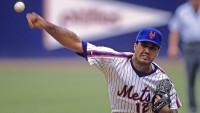
With the Mets announcing they are finally retiring Mike Piazza’s number, there have been renewed discussions regarding if there should be any other Mets who should have their number retired. You know the names: Gary Carter, Dwight Gooden, Darryl Strawberry, and, of course, Keith Hermandez.
Instead of arguing the merits of each of these players, I thought I would offer up a new name. Ron Darling.
Looking over Darling’s resume, he was a good, but not a great Met. He was 99-70 with a 3.50 ERA in nine years with the Mets. He won a Gold Glove, and he went to an All Star Game. He had a nice career, and he certainly justified the Mets trading away fan favorite Lee Mazzilli for him. Justifying a trade and having your number retired are two separate distinctions. Admittedly, Darling’s career falls well short of justifying his number retired.
The argument for his number being retired emirates from his current role with the Mets. He’s part of the already iconic Gary, Keith, and Ron. He calls Mets games from the Ralph Kiner TV Booth. That honor was bestowed upon Kiner, an original Met, and Mets broadcasting legend. Kiner was part of the original amazing Mets trio of Kiner, Lindsay Nelson, and Bob Murphy. The radio booth was named after the Hall of Famer Bob Murphy.
Darling is a terrific broadcaster in his own right. He’s so great he was picked up by TBS to do color commentary. As a member of the 1986 Mets and as a broadcaster, Darling has been an important part of Mets history. Since the TV booth already carries the name of Ralph Kiner, and deservedly so, we need to find another way to honor Ron Darling’s rich Mets career. The Mets should retire his number 12.
However, they shouldn’t do it before retiring Keith’s number 17.
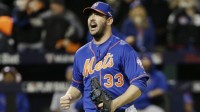
Even though Commissioner Rob Manfred said the NL will not have the DH anytime soon, he has opened up Pandora’s box with his previous comments that the NL could see the DH in 2017. With the Collective Bargaining Agreement expiring at the end of the year, the issue is still on that table. Accordingly, I believe it’s an issue that still needs to be addressed.
Now one of the key arguments anyone has in requesting the DH be implemented in the National League is because the move would increase offense. That is undoubtedly true. The corollary to this argument is that more offense will create higher ratings. It’s an axiom that is heard time and again, but is it true?
Before delving more in depth, there needs to be a clear understanding of baseball’s current business model. Baseball has become a regional sport. Part of this can be attributed to the rise of regional sports networks like SNY and YES. More likely, this is the result of every team having all 162 games televised. Given the choice, a vast majority of sports fans will choose to watch their team play than watch the National Game of the Week. For example, when ESPN has Wednesday Night Baseball, I’m watching the Mets.
The only real issue of what drives ratings is when the postseason begins. At that time, a fan has no other baseball viewing option. Whether you’re a die hard fan or a casual fan, you’re choices are limited.
For my determination of whether or not the DH helps with ratings, I selected the ALCS and the NLCS. With there being four division series shown at different times of the day, the issue of availability becomes murky. However, typically, MLB attempts to schedule the ALCS and the NLCS so there’s as little conflict as possible.
Last year, the NLCS between the Mets and Cubs was the most watched NLCS since 2010. The series averaged almost eight million viewers per game in what was a four game sweep. On the flip side, the ALCS was drawing record low numbers. There was a disparity of about three to seven million per game who watched each series. In 2014, the script was much different.
The 2014 NLCS featured the Giants and the Cardinals, two fairly historic and important National League teams. The Giants last won a World Series in 2012, and the Cardinals were in the World Series the previous year. This NLCS had terrible ratings. The Giants-Cardinals series drew about 4.5 million viewers per game. That was down two million from these teams NLCS two years earlier.
The 2014 ALCS between the Baltimore Orioles and Kansas City Royals drew terrific ratings. The series averaged 5.1 million viewers. It consistently outdrew the NLCS. It outdrew the NLCS despite having smaller media markets and less historic franchises. Was the difference the DH and the increased scoring that goes with it? No.
As we have seen, baseball will tend to attract more fans with better and more compelling series. It should be of no surprise that Mets-Cubs drew terrific ratings. These were two young teams with some terrific pitching going head-to-head. It also didn’t hurt these franchises had a history. It also doesn’t hurt that the Cubs haven’t won in forever.
So no, the DH and increased offense isn’t what is driving ratings. It’s the matchups. Plain and simple. If someone says the DH will hp increase offense and create better ratings, they are creating a narrative that simply does not exist. Sure, someone can argue that they don’t want to see a pitcher hit, but we also know it won’t stop them from watching a compelling game or series.
Overall, ratings is not a reason to bring the DH into the National League.

Every single one of us has our favorite players. Growing up, I loved Gary Carter. If I had a blog back in 1997, it would’ve been named ElectGaryCartertotheHallofFameNow.com.Finally, in 2003, The Kid was finally elected in the Hall of Fame. I wanted him to go in as a Met and for him to have his number retired by the team.
There would be controversy over his cap. To understand the controversy, we have to go back in time a bit. There was a time that players were not selecting caps due to the team they felt most closely aligned or where they accomished the most. No, players were selecting caps based upon financial incentives.
Dave Winfield received $1 million to wear a Padres cap on his Hall of Fame plaque when he was inducted in 2001. Winfield going into the Hall as a Padre wasn’t an egregious choice. He started his career there, and he played eight years there as opposed to nine with the Yankees. He did have better numbers with the Yankees, but he was also treated awfully by them. Steinbrenner dubbed him Mr. May to deride his production in a pennant race. Steinbrenner hired gamblers and private investigators to “dig up dirt” on Winfield to get out from under the contact. So no, it’s not surprising Winfield chose the Padres cap and the $1 million.
Winfield wasn’t egregious, but it was the sign of a larger problem. That problem would come to a head with Wade Boggs. There were rumors that Boggs negotiated in his contract that he would enter the Hall of Fame as a Tampa Bay Devil Ray. It forces the Hall of Fame’s hand, and they began the process of selecting player caps, even if it was against a player’s wishes. As we saw with Andre Dawson, it’s a move that benefitted the defunct Montreal Expos.
On the one hand, it’s a move that had to be made. You couldn’t have players and teams negotiating this away in one year contracts towards the end of a player’s career. The Hall of Fame does have some responsibility to preserve history. On the other hand, the Hall of Fame has overstepped its bounds a bit. Remember they did allow Reggie Jackson to enter the Hall of Fame as a Yankee (5 years) as opposed to the Athletics (10 years). They allowed Nolan Ryan to enter the Hall of Fame as a Ranger (5 of his worst years) instead of an Astro (9 years) or an Angel (8 years).
Carter played 12 years for the Expos, and 5 with the Mets. Based on the Jackson/Ryan standard he should’ve had his choice even if Carter was an Expo through and through. However, Carter wanted to go in as a Met. The Hall of Fame decided he would go in as the first Montreal Expos; a decision Carter did not object.
Unfortunately, the decision cost him. The Expos moved to Washington a year and a half after his induction. The franchise almost immediately unretired the number of their first Hall of Famer. Also, it cost Carter his chance of the Mets retiring his number 8.
As we saw with Mike Piazza, the Mets have set an exceedingly high standard for retiring numbers. For their players, the Mets have reserved that honor for players who have entered the Hall of Fame wearing a Mets cap. With one decision made by the Hall of Fame, not by Carter, Carter was cheated of his chance to have his number retired by the Mets. Sadly, even if the Mets reverse course, the day honoring Carter will be melancholy with his untimely death at the all too young age of 57.
If Carter isn’t there to enjoy the honor, I believe the moment has passed. As much as I may have wanted it one day, I don’t think the time is now. If the Carter family feels differently, I certainly would change my tune.
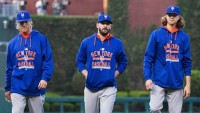
As a Giants fan, I love Eli Manning. Any true Giants fan would. The man won two Super Bowls picking up an MVP in each game. There’s always the debate if he’s elite or not. That conversation never concerned me because I knew that my guy could go up against Brett Favre, Aaron Rodgers, and Tom Brady (twice) and beat them in the biggest games. He inspires confidence. That’s all I could ask. That’s why he’s a big time QB.
That’s how I feel about the Mets current pitching staff. Last we saw them, they were leading the Mets to an improbable National League Pennant. Matt Harvey, Jacob deGrom, and Noah Syndergaard went out there and established they can pitch with anybody. Better yet, they established they can beat anybody. In the NLDS, it was Clayton Kershaw and Zack Greinke for two starts a piece. In the NLCS, it was Jake Arrieta and Jon Lester. Mets beat them all.
With Arrieta, Greinke, and Kershaw, the Mets beat the top three in the NL Cy Young voting. With Lester, the Mets beat a pitcher who has a 2.85 postseason ERA along with a 1.071 WHIP. Harvey, deGrom, and Syndergaard beat them all. Not only did they establish they can pitch with the best, they also established they can beat the best. That’s all you need to know about them.
Sure, the Mets rotation wasn’t ranked ahead of the Cubs rotation, nor was it ranked as the top rotation in baseball. None of the Mets pitchers were ranked as the top 10 pitchers right now. At the end of the day, who cares? Seriously. This stuff is to create and drive debate. What’s not up for debate is that the Mets Big Three can go against any other team’s pitching and win.
So while everyone can go on discussing who is and who is not elite, I’m perfectly comfortable watching my guys collect division titles and pennants. They’ve proven they can do that, and they will do it again. So yes, none of the Mets starters are in the Top 10 right now. At the end of the day, it doesn’t matter.
The Mets starters right now are number one in the National League.
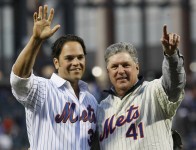
There are two things that are usually true about my birthday: (1) it always rains on my birthday; and (2) the Mets are not usually playing at home on my birthday. When the Mets are home on my birthday, the rain usually wrecks havoc with the Mets home game.
I was thinking about this when the Mets announced Mike Piazza Weekend. I’m assuming that entire weekend will be sold out. I know it was difficult getting good seats to the Saturday night retirement ceremony. As an aside, I would’ve retired Mike Piazza‘s #31 on July 31st instead of the 30th. Not a big deal, but just a quirk I noticed that will eventually drive either me or everyone else around me to a mental institution. I digress. It’s going to be awesome to see the fans come out the entire weekend. It’s a testament to how much we love Piazza and how good the 2016 Mets will be.
The entire weekend will be a celebration of Mike Piazza and the current Mets team. It’s a far cry from what Tom Seaver received when he had his Tom Seaver Night the year he was inducted into the Hall of Fame.
There are birthdays we have that always stand out in your mind, and August 12, 1992 is one of them. I got one of those newfangled CD players. I got to rock out to such musical visionaries as C&C Music Factory. Oh and by the way, it rained. Boy oh boy did it rain. Water was getting into the house. Seriously, 100 times out of 100 they call this game. However, there was zero chance the Mets were going to call this game because it was Tom Seaver Hall of Fame night. It was the night Seaver was going to receive his Hall of Fame ring in a pregame ceremony.
I know I was the only one in my family who wanted to go, but guess what; it was my birthday so we went. Seriously, my mother must’ve tried to talk me out of it like 41 times. Eventually, we went out. I remember on the way to Shea Stadium, the windshield wipers were at their highest setting, but it didn’t matter.
We made it to Shea Stadium in time for the ceremony. The announced attendance was 20,488. During the ceremony, there must’ve been a couple of thousand, and most of them were in the back rows of the Lodge and Mezzanine. The fans were mostly driven away by the rain. They were also driven away by a terrible Mets team. You might also remember them as The Worst Team Money Could Buy.
On that night, they were Terrific. In his third career start, Eric Hillman pitched eight scoreless innings against the hated Pirates. That night Hillman was every bit the 6’10” giant we thought he could be. That night at least Seaver was honored with a great pitching performance because he certainly wasn’t honored with the type of fan turnout he deserved.
Piazza won’t have that problem. Piazza will get three straight sell-outs and a good Mets team. I’m sure not even the rain could keep people away. I know it won’t stop me.
